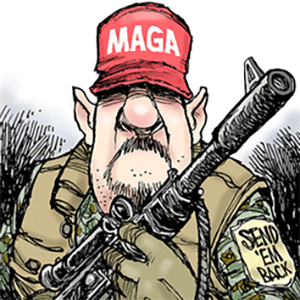Germany to do NATO 'heavy lifting' as allies ratchet up spending
Published in News & Features
Germany’s defense chief said his country will need to boost its armed forces by as many as 60,000 active soldiers as NATO member states commit to ramping up defense spending to deter Russia’s military threat.
Defense Minister Boris Pistorius said Germany would take on the second-largest burden among the North Atlantic Treaty Organization’s 32 member states as allies agree on a blueprint to re-arm. Defense Secretary Pete Hegseth reinforced the U.S. position that allies must spend 5% of GDP on their militaries.
The German minister touted Berlin’s new commitment to defense spending after it lifted debt restrictions on military investment, saying Europe’s largest economy will do the “heavy lifting” that would involve forming new military units and ensuring they’re fully equipped. Germany currently has about 182,000 active-duty troops.
“The time when we complained about the lacking budget of the past decades is past,” Pistorius said in Brussels Thursday during a meeting of NATO counterparts. “Today is the starting signal, we’re catching up. We have started, and we’re accelerating, and it’s urgent given the threat situation.”
NATO ministers are planning to sign off on one of the most ambitious commitments to raising weapons stocks since the Cold War. The agreement will lay the groundwork for a June 24-25 summit in The Hague, where leaders of the alliance will finalize the new 5% benchmark — one that President Donald Trump has demanded.
The list of weapons and military requirements that the countries have to fulfill — the so-called capability targets — won’t be made public, but the stock-up will include a plan to expand ground-based air-defense capabilities fivefold, filling a crucial gap.
Germany’s leadership is seeking to reassert the country’s position on the world stage. Chancellor Friedrich Merz, who took office less than a month ago, is traveling to Washington for his first meeting with Trump.
Shoulders to the plow
Speaking to reporters before the Brussels meeting, Hegseth — who skipped a gathering of the Ukraine Defense Contact Group on Wednesday — said he would ensure that the 5% target is met “as a recognition of the nature of the threat.”
“The reason I’m here is to make sure every country in NATO understands every shoulder has to be to the plow,” Hegseth said. “It’s that hard power that actually deters — and it can’t just be U.S. capabilities.”
Trump has been demanding that Europe take its security into his own hands, setting into motion a significant burden-shifting within NATO. The U.S. president in the past has raised doubts about whether the U.S. would defend allies who didn’t spend sufficiently on defense.
The 5% target would have been considered unrealistic not long ago. But NATO Secretary General Mark Rutte has forged a consensus on the target, which is comprised of 3.5% on core defense spending and another 1.5% on defense-related expenditure that would include areas such as logistics and cybersecurity.
How that figure adds up and what it includes remains a matter of negotiation. The target date under discuss is 2032, though a contingent of NATO allies is pushing for a 2030 date.
Estonian Defense Minister Hanno Pevkur reinforced Baltic states’ demands that the 5% benchmark is reached in five years.
“I know it’s not easy, we had to increase taxes, we had to cut the budget, we had to change many things,” Pevkur said in Brussels. “But we also understand that 5% during the peace time is much less than 35% — what Ukraine is paying at the moment during the war,” he added.
-----------
—With assistance from Michael Nienaber and Katharina Rosskopf.
©2025 Bloomberg L.P. Visit bloomberg.com. Distributed by Tribune Content Agency, LLC.






Comments